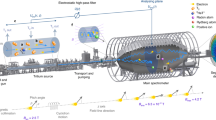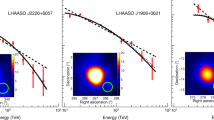Abstract
EVANS et al.1 (see also refs 2, 3) have presented data on the rate of production of 37Ar with the Brookhaven Solar Neutrino Detector; two facts stand out: the overall mean rate is low compared with expectation4, and one run, No. 27, may be significantly higher than the remainder. The present note is primarily concerned with the statistical significance and explanation of this high rate. The calculation of the rates and uncertainties is not a simple procedure and it is important to have an independent determination; with the cooperation of the authors, we have made our own analysis using their basic data (β-ray counter measurements of the β-activity of the abstracted 37Ar over successive periods of ∼30 d), for the important run 27.
This is a preview of subscription content, access via your institution
Access options
Subscribe to this journal
Receive 51 print issues and online access
$199.00 per year
only $3.90 per issue
Buy this article
- Purchase on Springer Link
- Instant access to full article PDF
Prices may be subject to local taxes which are calculated during checkout
Similar content being viewed by others
References
Evans, J. C., Davis, R., jun., and Bahcall, J. N., Nature, 251, 486–488 (1974).
Davis, R., Evans, J. C., Radeka, V., and Rogers, L. C., Neutrino '72, Proc. Europhysics Conf. (Balatonfured, Hungary, 1972).
Davis, R., and Evans, J. C., Proc. 13th Int. Conference on Cosmic Rays, 3, 2001–(Denver, 1973); revised version BNL 17945 dated 8.15.73 (Brookhaven National Laboratory).
Ulrich, R. K., Astrophys. J., 188, 369 (1974).
Meyer, B. S., thesis, pp. 110–115, (1969).
Wolfendale, A. W., Young, E. C. M., and Davis, R., Nature phys. Sci., 238, 130, (1972).
Strong, I. B., Klebesadel, R. W., and Olson, R. A., Astrophys. J. Lett., 188, L1–L3, (1973).
Zeldovich, Y. B., and Novikov, I. D., Relativistic Astrophysics, 1, 465, (Univ. Chicago Press, 1971).
Pallister, W. S., and Wolfendale, A. W., Neutrino '74, (Univ. Philadelphia, in the press).
Lande, K., Bozoki, G., Frati, W., and Lee, K., Nature, 251, 485–486 (1974).
Author information
Authors and Affiliations
Rights and permissions
About this article
Cite this article
PALLISTER, W., WOLFENDALE, A. Possible explanations of the ‘high’ number of counts in the solar neutrino experiment. Nature 251, 488–489 (1974). https://doi.org/10.1038/251488a0
Received:
Issue Date:
DOI: https://doi.org/10.1038/251488a0
This article is cited by
-
Galactic neutrino sources and experimental neutrino astronomy
La Rivista Del Nuovo Cimento Series 2 (1976)
-
Chemistry of the solar neutrino problem
Nature (1975)
-
Brookhaven solar neutrino detector and collapsing stars
Nature (1974)
Comments
By submitting a comment you agree to abide by our Terms and Community Guidelines. If you find something abusive or that does not comply with our terms or guidelines please flag it as inappropriate.



